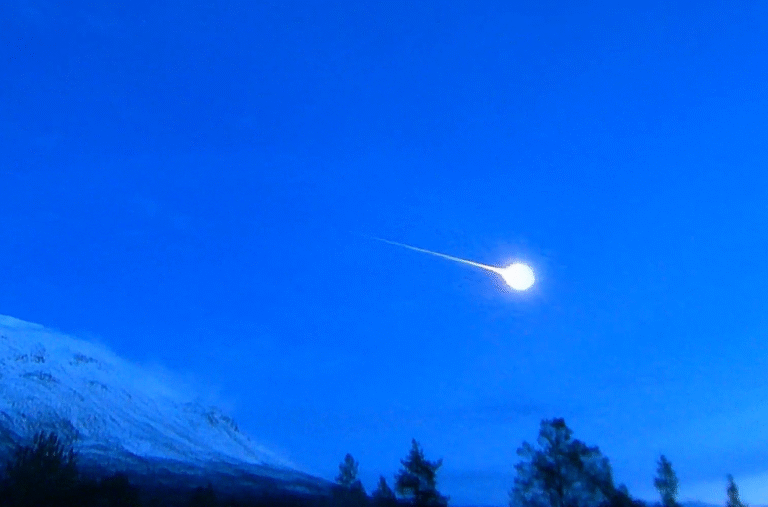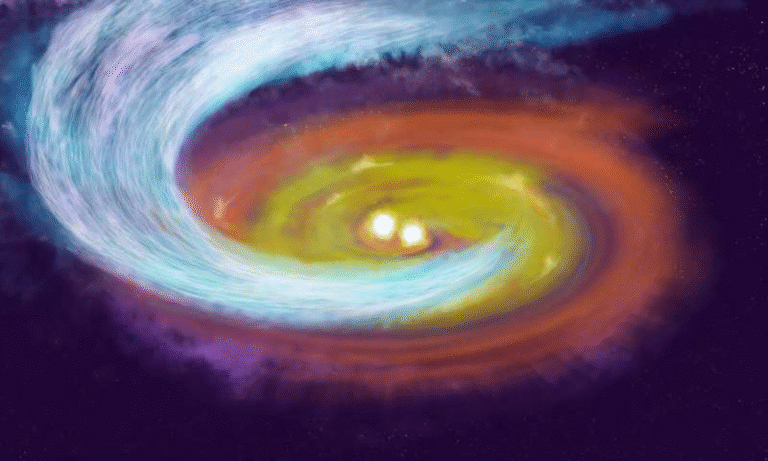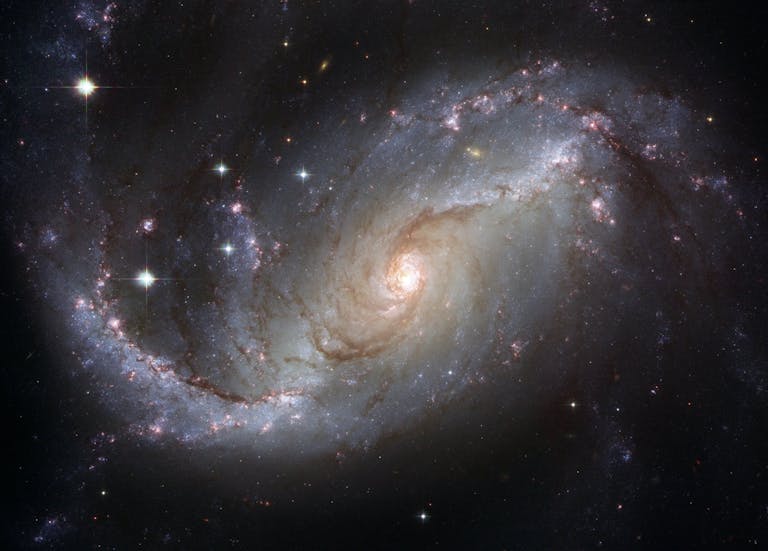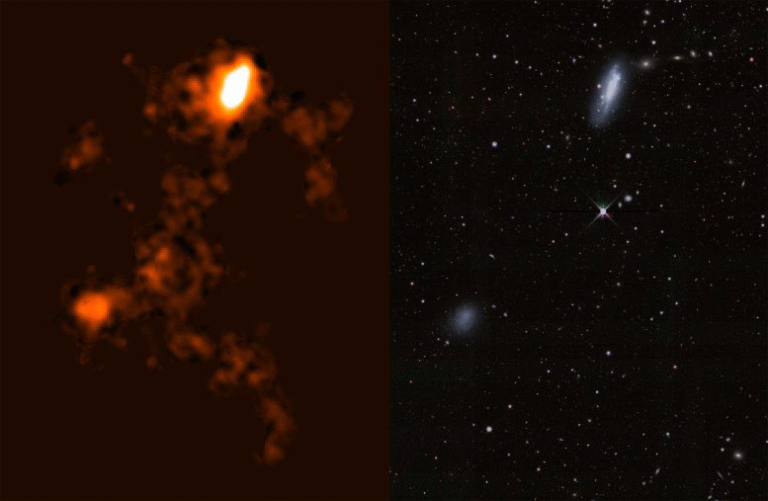Astronomers Capture First Direct Image of a Baby Planet Forming Inside a Disk Gap
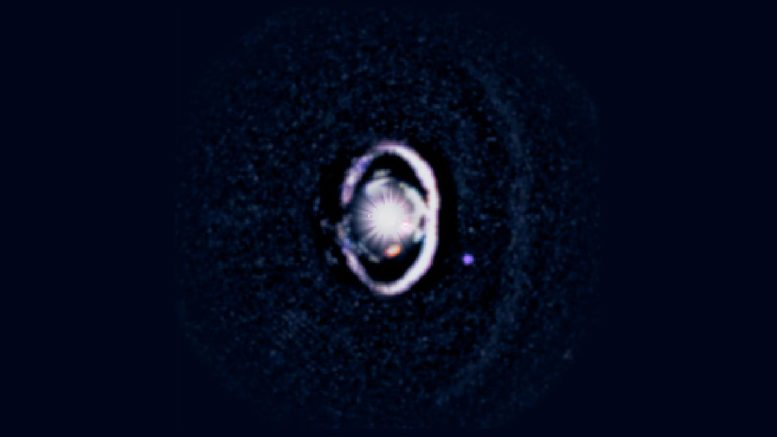
Astronomers have achieved something remarkable: they have directly photographed a baby planet, named WISPIT 2b, as it forms inside the dusty rings surrounding a young star. This is the first confirmed detection of a protoplanet embedded within the dark gaps of a multi-ring protoplanetary disk — regions that have long intrigued scientists but never provided definitive proof of planetary birth until now.
The finding comes from an international team led by Laird Close of the University of Arizona and Richelle van Capelleveen of Leiden Observatory. Their discovery settles a longstanding scientific mystery: whether the dark, well-defined gaps seen in protoplanetary disks are carved out by newborn planets or caused by some other phenomenon. With WISPIT 2b, astronomers can now say with confidence that planets are indeed responsible for sculpting these striking disk structures.
The Star System WISPIT 2
The baby planet orbits a star known as WISPIT 2 (also referred to as TYC 5709-354-1), a young, Sun-like star located about 434 light-years away in the constellation Aquila. Astronomers estimate the system to be around 5 million years old, making it an infant compared to our 4.5-billion-year-old Solar System.
WISPIT 2 is still in its pre-main-sequence stage, meaning it has not yet fully matured into a main-sequence star like our Sun. Surrounding it is a transitional protoplanetary disk, a swirling structure of dust and gas that extends out to about 380 astronomical units (AU) — far beyond the reach of Neptune in our Solar System.
The disk is not uniform. Instead, it is structured into multiple rings and gaps, much like ripples with missing bands in between. The innermost cavity is largely dust-free, followed by bright rings separated by darker annular gaps. Astronomers have long suspected that such gaps are carved out by planets sweeping through them, clearing paths in the dust much like a snowplow pushes snow aside.
The Baby Planet WISPIT 2b
The star of this discovery is WISPIT 2b, a young giant planet forming at a distance of about 54 AU from its host star — roughly twice the distance of Pluto from the Sun. Using precise measurements, astronomers determined its projected separation as 309.43 ± 1.56 milliarcseconds, which corresponds to that orbital distance when accounting for the disk’s tilt.
WISPIT 2b is estimated to weigh in at about 4.9 Jupiter masses, with a range of uncertainty from 4.3 to 5.8 Jupiter masses. This makes it significantly more massive than any planet in our Solar System. What makes it truly extraordinary is that it is actively accreting gas. As hydrogen falls onto the planet, it heats up and emits a specific glow known as hydrogen-alpha (Hα) emission, which can be observed by specialized instruments. This emission is direct evidence that the planet is still growing, feeding off its surrounding disk.
In other words, astronomers didn’t just find a planet — they caught it in the act of being born.
Another Candidate Planet: CC1
Alongside WISPIT 2b, researchers also spotted a possible second planet, currently referred to as CC1. This candidate lies closer to the star, inside the disk’s inner cavity, at a distance of about 14–15 AU. For comparison, that would place it between the orbits of Saturn and Uranus if it were in our Solar System.
CC1 is estimated to be about 9 Jupiter masses, though its status is not confirmed. It could indeed be another giant planet, or it may turn out to be a dense dust clump or some other structure within the disk. Further observations are required to clarify whether CC1 is a real planet or not.
How Astronomers Captured the Image
Detecting such faint planets next to bright stars is extremely challenging, but the team succeeded by using advanced adaptive optics instruments designed to counteract Earth’s turbulent atmosphere.
The main tool was the Magellan Adaptive Optics eXtreme (MagAO-X) instrument, developed at the University of Arizona and installed on the 6.5-meter Magellan Telescope in Chile. MagAO-X is optimized for detecting hydrogen-alpha light, making it perfect for spotting glowing gas falling onto young planets. By removing the blur of Earth’s atmosphere, MagAO-X can separate faint planetary light from overwhelming starlight.
In addition to MagAO-X, the team used:
- The Large Binocular Telescope (LBT) in Arizona to capture thermal infrared light from the system.
- The Very Large Telescope (VLT) in Chile with its SPHERE adaptive optics system to probe the disk’s structure in infrared wavelengths.
Combining observations across different instruments and wavelengths provided both direct imaging of WISPIT 2b and confirmation of its physical properties.
Why This Matters
This discovery resolves a major debate in astronomy. For decades, scientists have observed dark gaps in protoplanetary disks and theorized they were caused by forming planets. But direct evidence was lacking, and alternative explanations — such as disk instabilities or magnetic interactions — were also considered.
Now, WISPIT 2b proves that planets can and do carve out gaps. This is a breakthrough because it shows that the beautiful ring-and-gap structures imaged by telescopes like ALMA are indeed signs of active planet formation.
The system also provides a snapshot of a process that shaped our own Solar System billions of years ago. Astronomers note that WISPIT 2b and CC1 are reminiscent of Jupiter and Saturn when they were young, though much more massive and spread farther apart. Studying them offers a rare chance to watch giant planets grow in real time.
The Structure of the WISPIT 2 Disk
The WISPIT 2 system is particularly interesting because of its complex disk:
- Disk inclination: tilted at about 44°–46° relative to our line of sight.
- Outer disk edge: extends to around 316–380 AU.
- Ring-and-gap pattern: at least four rings and four gaps have been identified.
- WISPIT 2b’s gap: lies between two prominent dust rings, at ~54 AU.
These structural details make WISPIT 2 one of the most compelling laboratories for studying how multiple planets interact with their natal environment.
Context: Other Forming Planets
Only a handful of forming planets have ever been directly imaged. The most famous example is the PDS 70 system, where two protoplanets have been observed inside a disk. WISPIT 2b adds to this rare group but stands out as the first confirmed planet inside a well-defined disk gap.
This is a critical difference. While other detections involved planets closer to the star or at the inner disk edge, WISPIT 2b is precisely where theories predicted such worlds should be. This makes it the missing piece of evidence connecting observations of ringed disks to the presence of embedded planets.
How Protoplanets Form
Understanding WISPIT 2b requires a quick look at how protoplanets form.
- Dust grains stick together inside a protoplanetary disk, forming clumps.
- These clumps grow into larger bodies called planetesimals.
- If a planetesimal becomes massive enough, its gravity pulls in surrounding gas, forming a protoplanet.
- In the case of giant planets, runaway gas accretion allows them to gain several Jupiter masses.
As gas crashes down onto the young planet, it creates shocks that heat the material into plasma. This plasma emits hydrogen-alpha light, which is exactly what astronomers detected from WISPIT 2b.
What Comes Next
While WISPIT 2b is now confirmed, there are still open questions:
- How fast is it accreting gas, and how massive will it eventually become?
- Will CC1 turn out to be another planet or just a dust feature?
- How will the multiple rings and planets interact over time to shape the system’s architecture?
Future monitoring will track orbital motion and accretion rates. Instruments such as the James Webb Space Telescope (JWST) and upcoming extremely large telescopes may provide even more detailed views of this young system.
Lessons for Our Solar System
Studying WISPIT 2 is like looking back in time at the birth of our own Solar System. Astronomers believe Jupiter and Saturn formed in a similar disk about 4.5 billion years ago, likely influencing the distribution of material that built Earth and the other planets.
Seeing WISPIT 2b in action gives us a chance to compare theory with direct observation. It shows how giant planets emerge, how they carve out gaps, and how they interact with the disk to shape the final arrangement of planetary systems.
Broader Importance
The discovery also has implications for the study of exoplanets in general. Most known exoplanets are older and fully formed, detected through indirect methods like transits or radial velocity. But finding planets at the moment of their birth is rare.
By catching WISPIT 2b mid-formation, astronomers can test and refine models of planet formation. This includes understanding migration (how planets move through the disk), the timescales of gas accretion, and the processes that determine whether a planet becomes a Jupiter-like giant or remains a smaller world.
Final Thoughts
The confirmation of WISPIT 2b is more than just another exoplanet discovery. It is a direct window into planetary birth, something astronomers have long theorized but rarely seen with their own eyes. With advanced instruments like MagAO-X, LBT, and VLT, scientists have finally caught a giant planet in the act of accreting gas, glowing brightly in the hydrogen-alpha spectrum, and carving a gap in its natal disk.
This is a milestone in astronomy, resolving a decades-old debate and providing a new benchmark system for studying how planets and disks evolve together.
Research Reference: WIde Separation Planets In Time (WISPIT): Discovery of a Gap Hα Protoplanet WISPIT 2b with MagAO-X – The Astrophysical Journal Letters
